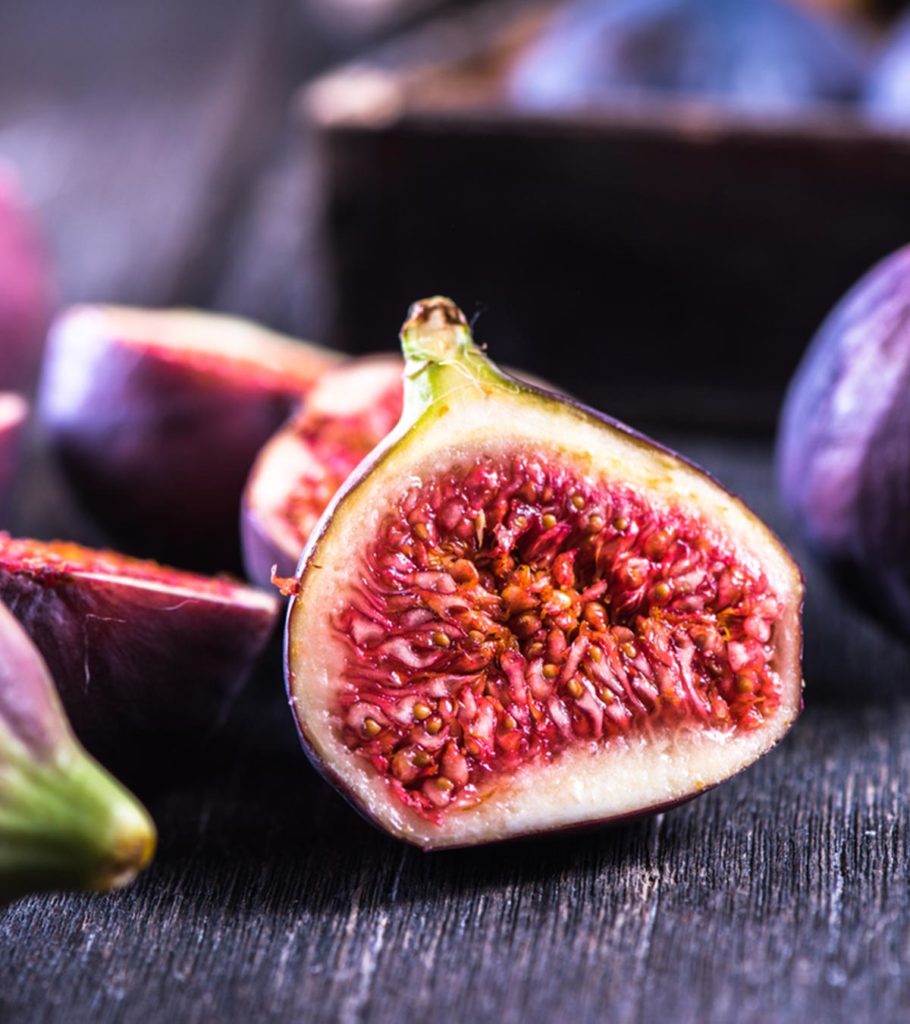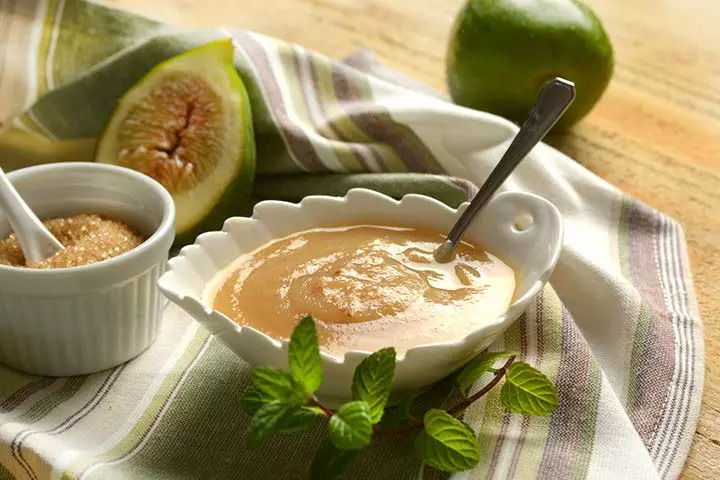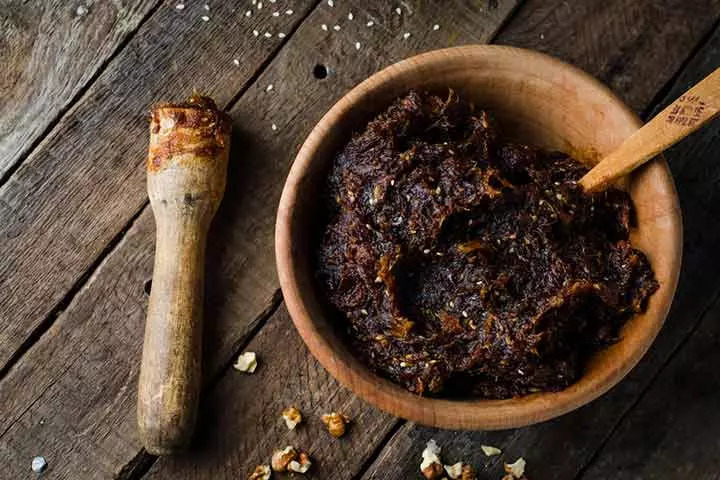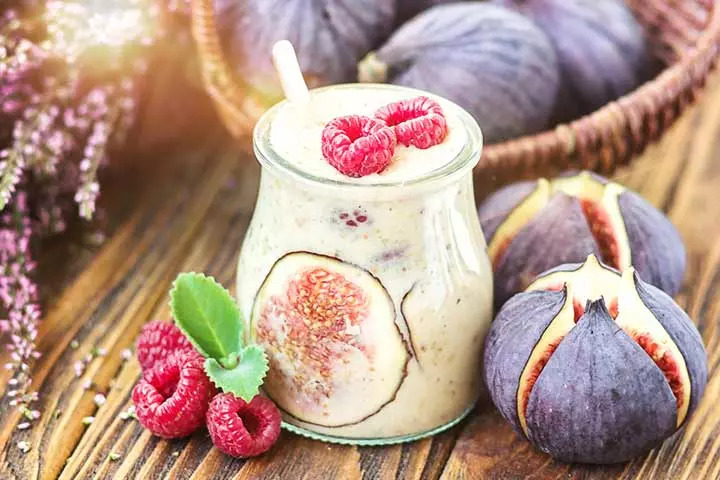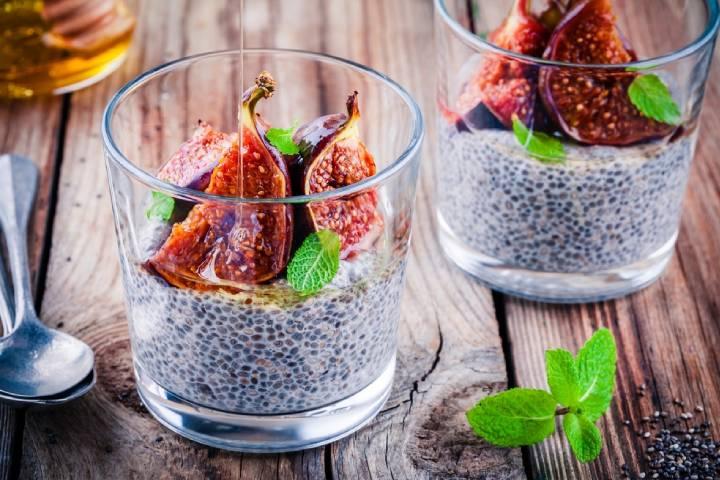Parents often ask their doctors when they can start figs for babies due to the several health benefits of figs. Fig is a delectable, nutritious fruit from the common fig tree (Ficus carica). It is from the mulberry family and has dark green to purplish skin. Ripe figs have magenta pulp that is filled with tiny edible seeds. They taste sweet and carry a hint of berry flavor.
Figs are available in fresh, dried, or canned forms. The nutritional value of a fig depends on the variety of the fig. Read this post to know about the nutritional value and health benefits of figs, the right age and way to feed figs to babies, and baby-friendly fig recipes.
When Can Babies Eat Figs?
Most babies can eat fresh, fully-ripe figs as puree or mash from six months of age. Once they adjust to fig’s taste and digestibility, you can add them to other foods, such as porridge. Once your baby is nine to ten months old, feed small, bite-sized pieces of figs as finger foods.
Babies between six and 12 months of age should not eat dried figs as they are a potential choking hazard (1). If you wish to feed dried fig to babies younger than 12 months, serve it in cooked, mashed, or puree form.
Nutritional Value Of Fig
Figs offer several vital nutrients, such as dietary fiber, potassium, calcium, magnesium, iron, phosphorus, antioxidants, and vitamins A, B, E, K and C (2) . One small, fresh fig (40g) added to your baby’s regular diet can offer the following nutrients (3) (4) (5).
| Nutrients | Amount | AI (7-12 months) |
| Water | 31.6g | – |
| Energy | 29.6Kcal | – |
| Fiber, total dietary | 1.16g | – |
| Calcium, Ca | 14mg | 260mg |
| Iron, Fe | 0.148mg | 11mg (RDA) |
| Magnesium, Mg | 6.8mg | 75mg |
| Phosphorus, P | 5.6mg | 275mg |
| Potassium, K | 92.8mg | 860mg |
| Vitamin A, RAE | 2.8µg | 500µg |
AI = Adequate intake – nutrient level assumed to ensure nutritional adequacy.
Sources: U.S. Department of Agriculture and Oregon State University
Possible Health Benefits Of Figs
The inclusion of figs in a baby’s diet could provide the little one the following benefits (6).
- Gives energy and hydration: One small, fresh fig (40g) provides 30kcal of energy and a considerable amount of water. These are necessary for young babies who have increased energy needs to sustain rapid growth and development.
- Offers vital micronutrients:Figs are an excellent source of potassium, iron, copper, magnesium, calcium, vitamin A, B and dietary fiber. These nutrients are necessary for different physiological functions that ultimately support a baby’s growth and development. Figs are antimicrobial in nature and strengthen the immune system..
- Provides antioxidants: FlavonoidsiXA group of naturally-occurring antioxidant and anti-inflammatory compounds found in plants and fruits, anthocyaninsiXDeep red, blue, and purple pigments found in plants, and phenolic compoundsiXCompounds found in fruits and vegetables and known for their antioxidant potential, such as gallic acid, chlorogenic acid, and epicatechin, provide fig its antioxidant properties (6) (7). Antioxidants boost immunity and improve long-term health.
- Boosts digestive health: Figs contain significant amounts of dietary fiber, primarily cellulose, that adds bulk and retains intestinal water. Both these features are necessary to maintain healthy bowel movements and keep constipation away. Some research studies even support the fig’s potential laxative effects (8).
How To Select And Store Figs?
Below are some tips that can help you carefully select and store figs for safe feeding.
Tips for selecting figs
- Pick ripe figs with clean, dry, and unbroken skin.
- Avoid figs with bruised, blemished or broken skin and those that turn mushy on pressing. A fresh fig is soft to touch yet stays intact when pressed.
- Smell a fig, and if it yields a sour smell, the fig is likely stale.
- Purchase dried figs sold in the sealed packages from a reputable brand.
- Buy canned figs in properly sealed containers. A dented or broken container indicates potential bacterial contamination.
Tips for storing figs
- Before storing, clean the fresh figs with a moist cloth. Transfer them to a plastic bag and store them in the refrigerator. Consume the figs within two to three days.
- Fresh figs can be frozen whole. Alternatively, you can store fig slices in a freezer bag or container. Both can be frozen and stored for up to 12 months.
- Store dried figs in their original package or in an airtight container , away from heat and moisture, at room temperature for a month. You can store them up to six months to a year in the refrigerator.
- Once the package is opened, store dried figs in an airtight container in the refrigerator away from heat and moisture. You can store them for six months to a year.
Precautions To Take While Feeding Figs To Babies
Figs are a good addition to your baby’s diet. While the introduction to solids is good and necessary, observing some simple precautions ensures your baby consumes figs safely.
- Buy organic figs from a reputable seller to ensure the quality of the fruit. Store them carefully as figs are delicate and bruise easily.
- Begin feeding fresh figs in mash or puree form to your baby in the weaning stage. Once the baby likes the taste and texture and can digest the figs comfortably, begin adding the fruit to other foods.
- Follow the “three-day wait” rule and during this time; feed only figs and no other new food to your baby. It helps rule out sensitivity, intolerance, or allergy.
- While spoon feeding, remember to introduce one to two teaspoons of pureed or mashed fig to your baby. Once the baby is comfortable with the fruit’s taste and digestibility, gradually increase the amount to a tablespoon or two.
- If the baby looks uncomfortable after ingesting figs, stop feeding immediately, and try again later. If the problem persists, consult a pediatrician.
- Fig allergy (oral allergy syndrome) is possible, and its symptoms come up immediately after ingesting or touching fresh or dry figs. Pay attention to allergy signs, such as itchy skin rash (hives), sneezing, wheezing, or sore throat (9).
- Babies allergic to fig may show cross-reactivity to weeping fig latex, natural rubber latex (latex-fruit syndrome), birch pollen, avocado, kiwi fruit, mulberry, and papaya (10) (11) (12). If your baby has a family history of allergies, consult a doctor before feeding figs in any form.
- Both fresh and dry figs might interact with certain drugs. If your baby is on medications, consult your doctor before adding fig to your baby’s diet.
- Don’t go overboard with figs. Feeding too many figs, especially dried figs, may cause gastrointestinal discomfort, such as diarrhea, in some babies.
Healthy Fig Recipes For Babies
Now, as you know about figs, let’s see some baby-friendly fig recipes that you can prepare for your baby. These are some easy homemade baby food recipes for you containing figs.
1. Fig puree
You will need:
- 1 fresh fig (peeled and chopped)
- 1tbsp breast milk or formula (optional)
How to prepare:
- Put the figs and water in a saucepan over medium heat. Cook the figs until the water comes to a boil.
- Then, lower the heat and cook the figs for 20 to 25 minutes.
- Turn off the heat and set the figs aside to cool.
- Once they are cool, blend the figs into a lump-free smooth paste.
- Add breast milk or formula to adjust the consistency and make the puree easy to swallow. You can add the puree to the porridge also.
2. Apricot and fig puree
You will need:
- 2 apricots (mashed)
- 2 figs (mashed)
- ¼ cup breast milk or formula
How to prepare:
- Put all the ingredients in a blender and blend well. Ensure the mixture is lump-free and has a smooth consistency.
- Pour the mix into a feeding bowl and feed the baby.
3. Roasted fig mash
You will need:
- 2 figs
- 1tsp olive oil
How to prepare:
- Preheat the oven to 400°F (204°C).
- Apply olive oil on the fig and place them on a baking tray.
- Bake them for about 18 to 20 minutes until their skin becomes puckered and soft.
- Once done, take the figs out of the oven and let them cool.
- Mash the figs thoroughly using a fork and feed. You can add breast milk or formula if you feel the texture is too thick for the baby.
4. Fig yogurt smoothie
You will need:
- 2 figs (mashed)
- 1 cup unsweetened, plain Greek yogurt
- ½ tsp nuts powder (almond, walnut, and pistachio)
How to prepare:
- Put all the ingredients in a blender and blend into a smooth, lump-free liquid. Add some water to adjust the consistency, if needed.
- Pour the smoothie into a feeding bowl and feed your baby.
- You can add oats to this smoothie and feed it to your baby.
5. Fig chia pudding
You will need:
- 6tbsp whole chia seeds
- 1 cup almond milk
- ½ cup yogurt
- 1/4tsp vanilla extract
- 4 figs
How to:
- Combine almond milk, vanilla extract, and chia seeds in a small bowl. Let the chia seeds soak for up to two hours or overnight in the fridge.
- Wash and peel the figs. Cut it into small pieces.
- Take a small jar and begin layering for the pudding. First, press the pieces of figs, then add a layer of chia pudding and then a layer of yogurt.
- Top it off with some more pieces of figs and serve.
Figs are nutritious fruits with many essential vitamins and minerals that aid in the proper growth and development of the baby. You may start feeding figs to your baby after the age of six months. Initially, introduce figs to them through a pureed form. Start to feed bites of figs as they near their first year of birth. Continue feeding them the fruit only if they are not allergic to it. Consult your pediatrician before feeding figs if your baby is on medications or is genetically allergic to the fruit.
Key Pointers
- From six months of age, babies can be given fresh or completely ripe figs in mashed or semi-solid form.
- They are a rich source of vitamins, dietary fiber, and antioxidants vital for a baby’s growth.
- Fig puree, roasted fig mash, and several other fig recipes as you scroll through.
